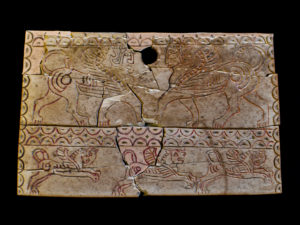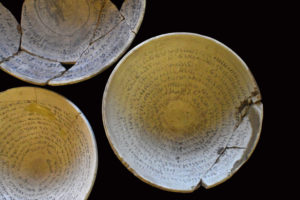Israel Antiquities Authority seizes hoard of stolen artifacts
Nathan Steinmeyer March 11, 2022 0 Comments 973 views


Stolen artifacts recovered by the Israel Antiquities Authority, including bowls, ivories, and coins. Photo by Yoli Schwartz, Israel Antiquities Authority.
In early 2022, the Israel Antiquities Authority (IAA) seized a hoard of stolen artifacts including carved ivories from the biblical period, 1,500-year-old magic bowls, and hundreds of other items. The stolen artifacts were discovered in the home of a Jerusalem resident who is thought to have been repairing and illegally selling them on the black market. This event illuminates the growing problem of looting at archaeological sites and the illicit trade in stolen antiquities in Israel and surrounding countries.


Stolen Artifacts: Biblical Ivories
Among the stolen artifacts uncovered by the IAA was a cache of carved bone and ivory objects bearing a close resemblance to the famous Samaria Ivories. Ivories served as a symbol of wealth and decadence in the biblical world. According to 1 Kings 10:22, Solomon’s trade ships brought back ivories from long voyages. For the biblical prophets, such ivories were also symbols of greed. The Book of Amos famously lambastes the Northern Kingdom of Israel through reference to its ivory furnishings: “Alas for those who lie on beds of ivory, and lounge on their couches” (Amos 6:4).


Carved ivory depicting two griffins and three winged lions. Photo by Yoli Schwartz, Israel Antiquities Authority.
The ivories seized by the IAA bear Egyptian motifs, including animals, mythical beasts, and geometric designs. Ivories of this kind would have been decorative items, attached to wooden furniture in the ninth and eighth centuries B.C.E. The IAA has suggested that these items were likely illegally excavated from Samaria, Megiddo, or another of the large biblical mounds of the region. Many similar ivories are on display in the British Museum and the Israel Museum.
Stolen Artifacts: Magic Bowls


Three incantation bowls with Babylonian-Aramaic writing. Photo by Yoli Schwartz, Israel Antiquities Authority.
The IAA also retrieved several magic incantation bowls that date back 1,500 years or more. The bowls were likely made in Mesopotamia between the fourth and eighth centuries C.E., where they were used as a kind of protective amulet. Written inside the bowls were various incantations in Babylonian-Aramaic. The bowls, which were often buried beneath houses, also include depictions of the demons that the vessels were intended to ward off. The IAA did not mention how these bowls ended up in Jerusalem. However, following the start of the Iraq War in 2003, countless ancient artifacts were looted or stolen from collections and then sold on the antiquities market. In addition to the ivories and bowls, the IAA also confiscated hundreds of ancient coins, weapons, and pieces of glassware.
Stolen Artifacts: The Problem of Unprovenanced Objects
The illicit trade in unprovenanced and stolen artifacts is a major issue across the world. Unprovenanced artifacts often come from unauthorized excavations or illicit digging. As discussed by Glenn J. Corbett, Editor of Biblical Archaeology Review, “These activities damage and destroy archaeological sites and their surrounding landscapes, but also cause the irrevocable loss of critical contextual information that can help archaeologists determine where, when, and how the objects were used in the past.”


A cache of silver and bronze coins recovered by the IAA. Photo by Yoli Schwartz, Israel Antiquities Authority.
The lack of archaeological context not only limits the amount of scientific data that can be retrieved from such objects but also makes them susceptible to claims of forgery. According to Eli Eskosido, Director-General of the IAA, “Unauthorized antiquities dealers encourage looters to go out and destroy ancient sites in search of finds for sale on the antiquities market. In the name of greed, they plunder antiquity sites, removing the finds from their historical context, thus obscuring parts of human history.” The penalty for illegally selling or purchasing ancient artifacts in Israel is up to three years in prison.
[embedded content]
Footage by Israel Antiquities Authority.
Read more in Biblical Archaeology Daily:
The Problem with Unprovenanced Objects
The Samaria Ivories—Phoenician or Israelite?
Hidden in Plain Sight—Painted Phoenician Ivories
Ancient Artifacts for Sale in Israel: What’s Legal?
All-Access members, read more in the BAS Library:
First Person: What to Do with Unprovenanced Artifacts—Publish or Perish?
First Person: Unprovenanced Antiquities: Learning the Hard Way
Ancient Ivory—The Story of Wealth, Decadence and Beauty
Not a BAS Library or All-Access Member yet? Join today.

